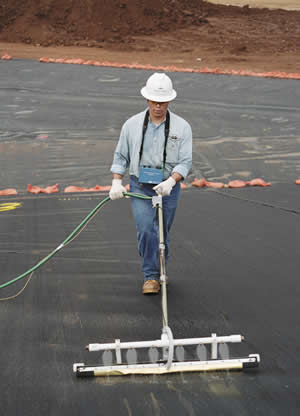A companion piece from Ian Peggs is also available. – The Editors
Water balance testing of geomembrane-lined ponds is an outmoded technology that is expensive to implement, causes significant project delays, and is subject to numerous measurement errors and tampering. The leak detection sensitivity for this method is very poor, and the method detects only the presence of leakage, not the location of the leaks.
A geomembrane leak location survey using electrical methods is technically superior to a water balance test, can be accomplished in days rather than weeks, and costs far less to perform.
COST
The expense of water balance testing is particularly onerous at sites where a suitable water source is not readily available. Usually the impoundment must pass the water balance test before waste water can be put in the impoundment, so available wastewater cannot be used for the test. The cost of the water can easily be $5,000 per acre, not including the labor costs, equipment costs, and fuel costs needed to transport and pump the water, or the cost of labor and expense required to properly monitor the test. The water must be properly disposed of after the test, requiring additional costs. The delay in acceptance of the pond may require costly alternate treatment or disposal of the waste stream.
TIME
The time required to perform a water balance test is also burdensome. In addition to the time required to monitor the leakage, frequently it takes a significant amount of time to fill the pond, empty the pond, and dispose of the water. If the impoundment is found to leak, this time, and the other costs are multiplied.
ACCURACY
The accuracy of water balance testing is uncertain. Even using the best protocols, it is problematic to accurately read the water levels, compensate for evaporation loss, and compensate for rainfall. Compensating for rainfall must account for the rain that falls on the unflooded side slopes that drain into the pond. Any rainfall drainage that flows into the impoundment from the surrounding berms or road surfaces will also cause error. The evaporation rate for a larger body of water is not the same as that for the smaller control container used to measure the evaporation. Differences in wind and wave action, wave spray, and temperature differences produce inaccuracies. Because of meniscus and wave effects, the water level usually cannot be read to accuracy greater than about 0.1 inches. This produces an uncertainty in the measurement of water loss of more than 2,700 gallons per acre.
BIAS
Water balance testing must occur over a period of weeks, during which time, the test can be subject to disruption, vandalism, and tampering. If the evaporation pan used for the control for the evaporation is disrupted during measurement, or if an animal drinks from the evaporation control pan, or bathes in it, the results will be invalidated. Most of the errors in the water balance test provide a bias in the favor of passing the test. The results of some water balance tests falsely indicate that water is created during the test!
ENVIRONMENTAL IMPACT
If the allowable water drop specification is relaxed so that a reasonably valid measurement can be obtained, the allowable leakage would be unacceptable for the environment. For example, one regulating agency allowed a drop of 0.125 inches per day for a wastewater evaporation pond. This is an annual leakage of 45.6 inches per year. The evaporation rate for the locale of the evaporation pond is 35 to 40 inches per year. Therefore, the pond, designed for evaporation, could leak more than it evaporated. The allowable water drop of 0.125 inches per day allows a leak of 3,395 gallons per acre per day, or more than 1.2 million gallons per year per acre. Most would consider this leakage rate to be unsatisfactory for most geomembrane-lined facilities, and the allowable leakage rate is unacceptable for environmental protection.
THE ALTERNATIVE
Geoelectric leak location surveys of geomembrane liners are far superior technically, require days instead of weeks to perform, and cost far less than water balance testing. The methods can easily detect leaks that would flow an order of magnitude less than that indicated by water balance testing. The geoelectric method accurately locates leaks rather than just detects the presence of leaks. If a pond is found to leak during a water balance test, the leaks must still be found, probably using the electrical leak location method anyway. Therefore, it does not make sense to require an unsound technical approach that adds significant cost to the owners and ratepayers, adds unnecessary delays to the commissioning of the facility, and allows unacceptable environmental damage.
A geoelectric leak location survey is much better, less costly, and much faster; and it results in optimum environmental protection.
Glenn T. Darilek and Daren L. Laine are the principal engineer and president (respectively) for Leak Location Services Inc., San Antonio, Texas.












